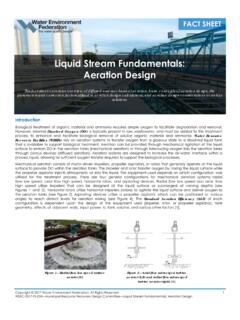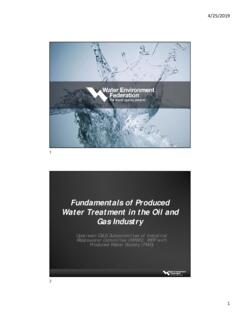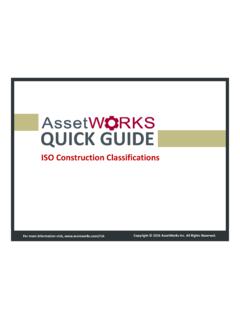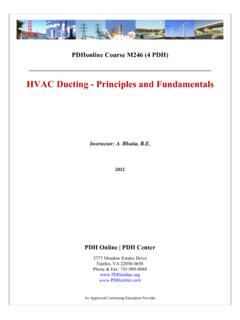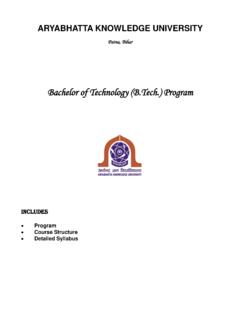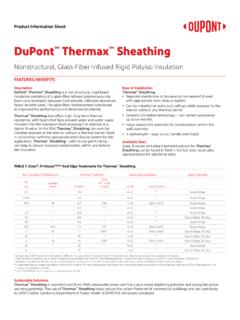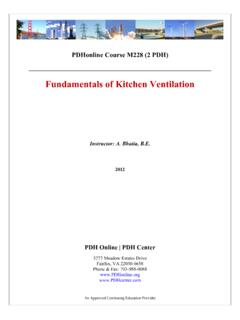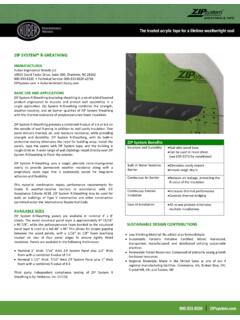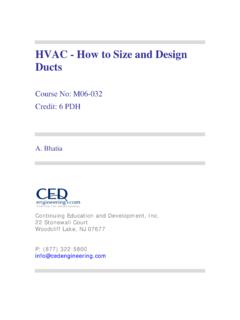Transcription of Anaerobic Digestion Fundamentals
1 Anaerobic Digestion is a solids stabilization process commonly used at municipal and industrial water resource recovery facilities (WRRFs). The primary objective of Anaerobic Digestion is to convert the microbiological cells and other solids generated during the treatment process to a stable end product. Other solids stabilization processes include aerobic Digestion , composting, thermal drying, thermal oxidation, and alkaline stabilization. Anaerobic digesters typically consist of concrete or steel tanks and receive solids from separation processes in the liquid treatment train. Solids may be comprised of settled material from primary clarification and secondary clarification, as well as scum and grease. Fats, oils, and grease (FOG) or food waste from sources outside of the WRRF also may be fed directly to digesters in some applications. Similar to other stabilization processes, Anaerobic Digestion reduces odors and pathogens in the solids stream.
2 Following stabilization, the digested product, referred to as biosolids, may be removed from site for disposal or processed further to reduce water content in preparation for disposal or beneficial reuse. The primary benefit of Anaerobic Digestion compared to other forms of solids stabilization is the energy recovery potential. Unlike the other commonly used stabilization processes, Anaerobic Digestion generates a biogas comprised primarily of methane and carbon dioxide that may be recovered for beneficial use such as heat or power generation. The potential for resource recovery has led to increased use of Anaerobic Digestion in recent decades. PROCESS DESCRIPTION Anaerobic digesters may receive solids from upstream processes in the liquid treatment train or FOG and food waste from outside sources such as restaurants and other commercial or industrial facilities.
3 The solids from upstream processes typically are comprised of primary sludge, secondary sludge, scum, grease, and/or other solids and liquids that may enter the solids collection system (including grit). Solids handling pumps like progressive cavity or rotary lobe pumps typically convey solids to the digester tanks. Intermediate steps may be implemented prior to Digestion to improve the process efficiency or prevent excessive maintenance on tanks or equipment. Grinding helps prevent maintenance issues by shredding large or stringy material into smaller components. Screening also prevents maintenance issues by removing large or stringy materials. Degritting improves process efficiency by preventing accumulation of grit inside digester tanks. Grit is particularly concerning. The accumulation of settled grit and other inert solids within digester tanks reduces the effective treatment or Digestion volume.
4 This Digestion capacity reduction hinders the stabilization performance, reduces gas production, and increases the frequency of tank maintenance and cleaning. Solids blending (combining separate streams such as primary sludge and waste activated sludge into one feedstock) and temporary storage in a holding tank also may be implemented upstream of the Anaerobic Digestion process. Blending and storage produces a more homogeneous loading and minimizes digester feed flow variability. Feed variability (in quality or flow) may cause digester foaming issues and require more maintenance. Anaerobic Digestion Fundamentals Anaerobic Digestion is a sustainability staple at resource recovery facilities. In addition to performing vital solids treatment processes such as stabilization and volatile solids reduction, Anaerobic Digestion also generates biogas that can be used at the resource recovery facility to generate heat and power.
5 FACT SHEET Copyright 2017 Water Environment Federation. All Rights Reserved. 1 WSEC-2017-FS-002 Municipal Resource Recovery Design Committee Anaerobic Digestion Fundamentals An additional intermediate step prior to Digestion may include solids thickening. In this process, the water content of primary and/or waste activated sludge is reduced. Process examples include gravity thickening, rotary drum thickening, and gravity belt thickening. By reducing the overall volume of digester feed sludge, thickening may reduce the equipment and tankage capacity required for Digestion , conveyance, or storage, as well as the energy required for digester heating, and chemical use for additional conditioning (if required). Following any intermediate processing or thickening, solids are conveyed to digesters.
6 Many different digester configurations, shapes, and flow patterns are available depending on the quality of the digester feed and the primary process objectives. These process objectives may be based on the degree of volatile solids reduction, gas production, or pathogen destruction required. Table 1 (p. 2) provides a brief introduction into some of the digester process options. Table 1. Common digester configurations Mesophilic Digestion is by far the most common method of Digestion , followed by thermophilic. Other methods, such as temperature-phased Anaerobic Digestion (TPAD) and acid/gas-phased Anaerobic Digestion (AGAD), are far less common and are less rigidly defined compared to mesophilic and thermophilic Digestion methods. For example, the TPAD configuration may include an initial acidic stage, and the AGAD configuration may include an initial thermophilic stage.
7 Regardless of the configuration, the objective of digester operation is to create an environment that promotes organic decomposition and reduction of inorganic matter. This is accomplished primarily by maintaining a certain temperature (depending on the Digestion method) and ensuring sufficient mixing. External heat exchangers typically are used to maintain sufficient temperature within the digester. Spiral type heat exchangers and water bath type heat exchangers increase the temperature of solids by exposing a pipe containing solids to high temperature water. As the solids pass through the heat exchanger piping, energy (heat) is transferred from the hot water to the solids. Solids (at an elevated temperature) then return to the digester to increase or maintain the temperature of the contents. Numerous methods are available to maintain digester contents in suspension, including pumping from one location within the tank to another.
8 This uses an external draft tube or an external centrifugal pump. Mechanical mixing via an impeller or linear motion mechanism located within the tank or gas injection are other mixing methods. The biogas that forms during Anaerobic Digestion is a result of the biological decomposition of organic matter taking place in the absence of oxygen. Methane (CH4) makes up 65% to 70% of biogas, while carbon dioxide (CO2) comprises about 25% to 30%. Trace quantities of nitrogen (N-2), hydrogen (H2), and hydrogen sulfide (H2S), water vapor, and other gases make up the difference. The energy potential of methane makes biogas a valuable resource as mentioned above. The heat produced by burning biogas fuel in a boiler may be utilized to heat water for use in a heat exchanger or for the facility s building heating system. Cogeneration or combined heat and power (CHP) systems are used to produce heat and to convert the energy contained in biogas to useable electrical energy.
9 Microturbines, gas turbines, or internal combustion engines connected to generators are used to produce electricity, which may be used onsite or exported to an external power grid. Copyright 2017 Water Environment Federation. All Rights Reserved. 2 WSEC-2017-FS-002 Municipal Resource Recovery Design Committee Anaerobic Digestion Fundamentals Anaerobic Digestion method Operation Advantages Mesophilic Temperatures may range from 35 C to 39 C most common Digestion method produces biosolids and biogas for beneficial use Thermophilic Temperature may range from 50 C to 57 C improved pathogen destruction higher quality biosolids produced improved gas production reduced volume requirements (due to increased reaction rate) Temperature-phased Mesophilic and Thermophilic operation reduced thermophilic heating vol-ume improved volatile solids destruction increased gas production Acid/gas phased Multiple phases including acid stage (with pH conditions below ) and gas stage (with neutral pH conditions)
10 Improved volatile solids destruction foaming control Higher-value fuels such as compressed natural gas (CNG), liquid natural gas (LNG), or methanol may also be produced from biogas. While these fuels are considered higher-value, the processes for producing and using CNG, LNG, and methanol are more complex in comparison to using biogas for heat and power generation. As technology advances, the use of biogas to produce these higher-value fuels may become more common. Prior to use, biogas must be pretreated to remove impurities and other substances which may cause maintenance and process efficiency issues. The water vapor present in biogas reduces process effectiveness, and may be removed by sloping biogas piping toward sediment/drip traps that collect condensed water vapor for disposal. Hydrogen sulfide, when combined with water vapor, forms a weak acid that may damage biogas piping or equipment.

